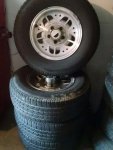Technical explanation, after which you can make an informed decision:
Ranger wheels are hub centric (you can tell as the wheel bolt treads start right at the hub). When rim is correctly installed, the weight of the vehicle passes straight from the rim to axle via the hub (bolts don't carry any weight; their purpose in life is to hold wheel against hub aka prevent from falling off, and to ensure wheel and axle rotate at same speed).
Ford used 2 sizes of hubs in Rangers: 2.50" for '83-97 2wd/'83-94 4wd and 2.83" for '98-11 2wd/'95-11 4wd. Unfortunately, interchange lists don't note there are deer hoof rims in both sizes and differentiate...
So, if you want to use newer rims on an older truck, you should use hub spacers of 2.5" id/2.83" od; otherwise, the threads of the bolts are carrying the weight of the vehicle. Lots of people have got away with mounting wheels lug centric but stressing a location which is already a stress concentration (threads) is asking for failure. (Common reason "generic" wheel spacers fail.)
Conversely, if you want to run older rims (your case), you should have the center bore machined to the larger 2.83", so when install the wheel, the rim is both tight and concentric with the axle. (If you don't keep the center bore concentric on the rim, you set up an out of balance condition).
So, ask yourself: Can you grind the hub so it is accurate (both diameter/concentric) and/or is it work the risk? Alternately, is it worth the cost to un-mount the tires, get a machine shop to enlarge the center bores and then re-mount/balance the tires? (I have my own tire changing tools and worked in an engineer prototype shop, so could do the machining myself on weekend, so for cost of re-balancing, it was worth it for me).
p.s. Center caps was a style thing; has nothing to do with 4wd, other than the style might have been mean to represent 4x4. 4wd actually doesn't have the caps on the front wheels.














